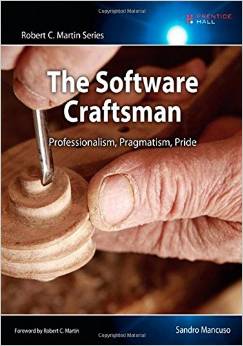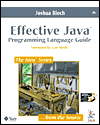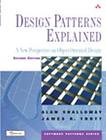 The Pragmatic Craftsman
:: Simplicity from complexity : by Stanley Kubasek ::
The Pragmatic Craftsman
:: Simplicity from complexity : by Stanley Kubasek ::
 The Pragmatic Craftsman
:: Simplicity from complexity : by Stanley Kubasek ::
The Pragmatic Craftsman
:: Simplicity from complexity : by Stanley Kubasek ::

The Software Craftsman
by Sandro Mancuso
ISBN 0134052501
Date Read 1/2015
My Rating

I just finished a book on software craftsmanship: The Software Craftsman – Professionalism, Pragmatism, Pride. It’s a good intro to what a craftsman does and what he should do.
I enjoyed reading it. Throughout the book I kept nodding, saying “yes,” or “agreed.”
It’s a good book for junior programmers. It can help you get on a right path. It can give you motivation to do things right. I would have enjoyed the book a lot more earlier in my career.
For more experienced people, for people that consider themselves a craftsman (like myself), it’s a quick and enjoyable read. I did not learn much, though. So in a sense, I could have spent my time elsewhere. But I think it’s good to find out that people think “like me” are out there. It’s good to read about their experiences. Plus, it’s a quick read.
I did learn a few things.
The author gave me an idea to try in our daily standups. I will introduce “What have you learned yesterday?” question. The team I manage has learning as one of our principles. It’s a good idea to raise the importance of of, and be reminded on a daily basis. I will do that.
The 2nd motivation I got from the book is about Community of Practice. I am thinking of starting one at my company. It will be based on best practices, new technologies, things worth checking out, etc. I think it’s a great idea that will allow me and other seasoned developers to step up and share some of the things we’ve learned.
Those learnings seem small but I consider them big. They’re leadership activities, IMO. And having learned that from this book makes it totally worth reading for existing craftsman. You will probably learn a few things from it as well.

Effective Programming: More Than Writing Code
by Jeff Atwood
ISBN B008HUMTO0
Date Read 9/2012
My Rating

I’ve been following The Coding Horror blog for at least a few years. When I heard that the author released a book, via a blog post on the blog, ![]() , I felt both excited and unexcited. Excited because I like author. Unexcited because I discovered that it’s mostly reprints from the blog. However, the price of $2.99 for the book pulled me in. And I’m glad it did.
, I felt both excited and unexcited. Excited because I like author. Unexcited because I discovered that it’s mostly reprints from the blog. However, the price of $2.99 for the book pulled me in. And I’m glad it did.
You might have read a few posts from the blog, but most likely not all. When put together as a book, I was inclined to read it from cover to cover. My success rate on reading blog posts, especially longer ones, is low. So most of the material was new to me.
Excellent topics! Let’s take an overview of the sections:
Those are sections and they each contain a few chapters.
Easy to read. And fun! Most of the chapters are short. I love books like that. I can easily read one or two chapters on a train. This was a perfect book for that. The author can write. Sometimes he made me laugh. But I really enjoyed the easy to read, conversational style.
Filled with lots of tips. I’m not a newbie to programming, but I’ve learned a few things: few things about chairs, lighting, application pricing, ui, code reviews, testing, and lots more. Along the way, I kept saying to myself: I couldn’t say it better; I can’t agree more. Nothing really ground braking, but still…
Not all chapters were interesting. A few I decided to skip after reading a few paragraphs. But there were only a few, I think two or three.
A great book to pick up and read casually. You will enjoy it. I can almost guarantee that you will learn something new and find a few facts fascinating. And if you think books are too expensive, then is $2.99 too much? Now I get the chapter on pricing! ![]()

Effective Java (2nd Edition)
by Joshua Bloch
ISBN 0321356683
Date Read 1/2011
My Rating

I read the 1st edition (my recommended book) a few years back. I just re-read the 2nd edition. It’s one of the best Java books around (the other must read would be Java Concurrency in Practice).
Read it.
Re-read it.
The 2nd edition is a little harder to read. Some chapters are too long and are not as cohesive (not like they were in the 1st ed), but still, getting all these tips from a Java champion is very valuable. At the very least, you can use his tips to win your arguments and influence others on your team.
And that’s the reason I’m recommending this book: read it to become a better Java programmer. Isn’t that a good reason? ![]()

Pro JPA 2: Mastering the Java™ Persistence API
by Mike Keith, Merrick Schincario
ISBN 1430219564
Date Read 4/2010
My Rating

If you’re learning or planning to learn JPA 2, you must own this book. Why? It’s the most complete book on the subject out there. It’s like a JPA bible.
Just a warning: It’s not an easy read. You will most likely have to read some (if not all) chapters at least twice. Some even more. For your first read, it will probably feel dry. Only after you learn by doing, by practicing, you will start “getting it.” This was at least my experience. I really started seeing the power of the book after reading selective chapters again. But of course, your experience might be different.
This is your JPA 2 bible. JPA 2 seems easy on the surface. But if you’re doing a project at work and it requires some advanced mapping, for instance, it’s not so trivial. The nice thing about this book is that it covers the advanced topics as well. And it shows you plenty of examples.
Few missing pieces. Cache coverage is light. Not much to it. Sometimes I felt that a full example, rather than a snippet, would be more appropriate. A few times I had to search the internet to get it to work. And as I mentioned before, this book is not an easy read, be prepared.
Excellent job by the authors. Excellent resource on JPA2, which I think is a great ORM spec.

Beginning Java™ EE 6 Platform with GlassFish™ 3
by Antonio Goncalves
ISBN 1430219548
Date Read 12/2009
My Rating

If you’ve been following the Java EE world, you know that Java EE 6 along with Glassfish v3 application server were released recently. This book has been around since mid year! And it’s still the only book on the subject. To me this was a great gift: I was able to get a complete sneak peek at the new technologies to be released ahead of time.
But was it worth it?
Great overview. If you want to learn what the buzz in the Java Enterprise (EE) world is all about, this is a great book to read. The author does a great job in keeping things at a fairly high level. He focuses on giving you just enough details (but not more), so you can actually start playing around with the technology. That makes this book easy to read. And practical — pragmatic!
Covers the important EE technologies. JPA. JSF. EJB. JMS. Web Services (SOAP and REST). JPA is covered really well. Four chapters dedicated to that. Four chapters for EJBs as well. And three for JSF. Two for each of the web services specs (one for SOAP and one for REST). The coverage on these should be enough to get you started and start playing around. The other technologies are covered very briefly.
Quick read. Not too deep. Not too shallow. This is the author’s style. It’s easy to read. The author gives you a lot of examples in between. On the other hand, at times, it would be nice to have a deeper treatment of a given technology.
Lots of examples. I love to see that. But not every chapter is treated the same. Some chapters have a complete example (Putting It All Together), and some don’t. I was able to run the examples from some chapters but not from all. I had to modify several to make it work. I wish a greater care was put in this area. It’s frustrating when you try to run something and you can’t. But if you’re willing to research it by yourself, you will learn more! I guess that’s the upside. But it does slow you down a bit.
Some technologies are not covered. CDI, is not there. Very light treatment of bean validation.
Overall, an excellent overview of Java EE 6, but not a complete guide/reference on the subject. I was very happy to see this book. And I’m very happy that I had read it. From what I see (at least on Amazon), a second edition will come out in a few months — might want to wait for that. Overall, a very good book on Java EE. Recommended.

Design Patterns Explained
by Alan Shalloway and James R. Trott
ISBN 0321247140
Date Read 8/2009
My Rating

Excellent intro to Design Patterns. I really liked the authors’ focus on teaching not only design patterns but how they should be used and implemented. Really good job there. I think this is a great book to start learning design patterns. If you want to learn DP, start with this book before you dive into the GoF Design Patterns book. Much to learn from this book, with a slow, more thorough way.
Not really a reference book. I tried to read this one quickly so I can get a quick refresher. This book is not suitable for that. Long explanations, not that much source code for examples. Yes, the explanations are good, but not if you want to quickly scan and refresh your memory. For that reason, I think the classic GoF book is still the king.
Overall, I appreciate the authors focus on teaching the right way of programming; trying to instill the “correct” thinking about patterns; and the detailed explanations of the different design patterns. I am disappointed that only a subset of patterns were explained and that this book is not suitable for reference. But all in all, a decent book.

Software Architecture Design Patterns in Java
by Partha Kuchana
ISBN 0849321425
Date Read 7/2009
My Rating

Good concept, bad implementation. After reading a few books on Design Patterns, I wanted to check out something else. Title of this book and decent reviews drew me in. I’m disappointed. After reading 20 chapters, I’m going to stop. I just don’t feel the author is doing a good job. There is not enough explanation on the different design patterns. The author gives a quick overview and then gives you an example. There is nothing wrong with that. But it’s very light. Each pattern is not explained enough. No benefits/drawbacks. No counter examples. Nothing really that will make the pattern “stick.” I just can’t learn anything from this book.
If you’re looking for a GoF book in Java, I would check out Design Patterns in Java or Design Patterns Explained. Not great, but I think they do a better job of explaining each pattern.

Pro JavaScript Design Patterns
by Ross Harmes, Dustin Diaz
ISBN 159059908X
Date Read 6/2009
My Rating

After reading a few books on JavaScript, I wondered… I wish there was a JavaScript book on Design Patterns. I was very glad when I found this book! It’s an advanced book loaded with great content, interesting style, and practical examples.
2 in 1. Not only do you get a refresher on Design Patterns, but you get to see some advanced JavaScript. It’s a really good combination.
Design Patterns/Javascript combination. This is a design patterns/JavaScript book. That said, you will not really learn JavaScript from it. Similarly, if you want to learn Design Patterns, you are better off going somewhere else. But if you combine these two, and don’t really focus on either one, you get a nice result. That’s exactly what this book is all about: how to implement some GoF patterns in JavaScript.
Design patterns. Which ones? Not all of them, but majority. Looking at the TOC, 12 GoF patterns are covered (Singleton, Factory, Bridge, Composite, Facade, Adapter, Decorator, Flyweight, Proxy, Observer, Command, and Chain of Responsibility). Plus the authors included chapters on Interfaces, Encapsulation, Information Hiding, Inheritance, and Chaining.
Best practices. The authors focus on creating best-practices solutions. I love that. I also love the authors style of code. You get to learn several different styles of creating JavaScript objects. (Could use a bit more explanation about them, but this is not an intro book.) I like to learn from examples, and there are plenty in this book.
Heavy on code examples. Light on explanation. I said it before, the way this book is written makes it suitable for you only if you have a good grasp of JavaScript and GoF Design Patterns. But still, I found this book hard to understand at times. I lost focus a few times. I think the authors could have done a much better job in this regard. The authors briefly explain the pattern and then they give you a long example. A short explanation follows. Very brief. If you don’t understand the full example, you’re out of luck. I would like to see short snippets extracted from the full example and explained. Repeated. So you learn better. And clearer that way.
Plan to re-read. You are most likely not going to “get” this book on your first read. I plan to re-read it. I will take it as an opportunity to deepen my GoF design patterns knowledge. Sort of read two books at once. Sounds like a plan. ![]()
I really liked this book. Design patterns knowledge is very relevant. JavaScript is gaining popularity and getting more advanced. It’s becoming a real programming language. I am still surprised how far it has come. This book is a really good gift to both communities. I highly recommend this book. It’s just the the book I was looking for!

DOM Scripting
by Jeremy Keith
ISBN 1-59059-533-5
Date Read 5/2009
My Rating

I believe in doing things the right way. So does the author of this book. In this regard, this is a great book: You learn what the right way is.
Not for hard-core developers. The intended audience is web designers. I second that. This book is also an excellent choice if you’re just thinking whether web-development with JavaScript is for you. Or if you want to read about web-development’s best practices (read chapter 5). It is not thorough and does not cover the advanced topics, like OO programming, etc.
Doing things right. And how to get there. This the nicest feature about this book. Slowly, sometimes first showing the bad approach and then refactoring to a more best-practices oriented solution. Nicely done. I wish more beginning books had an approach like this.
Separation of concerns: Separation of layers. My main objective for reading this book was so I learn more about the best practices. I did not learn anything new, but reading about the best practices again is a nice refresher. Separating structure, presentation, and behavior is the most important best practice when doing web development. The author does a good job explaining and really diving into this concept.
To say it once more, HTML, CSS, and JavaScript should be separate. You’ll learn that in this book.

Object-Oriented JavaScript
by Stoyan Stefanov
ISBN 1847194141
Date Read 5/2009
My Rating

After reading my last JavaScript book, Professional JavaScript for Web Developers, I was looking for some more JS books to read. Something good. Then a few days ago I read a post by Klaus Komenda, Book Review: Object-Oriented JavaScript, and he highly recommended this book. (In the process, I also discovered DOM Scripting, and Pro JavaScript Design Patterns.) I picked up this book and had high expectations.
Decent book. After finishing the excellent Professional JavaScript for Web Developers book, the standards were set very high. This book is good, but not as deep, and not filled with as many full examples. It’s good, but not as good.
Quick. This book reads very quickly. The examples are short, the writing style is very conversational. That’s a nice feature. On the downside, sometimes a feature you’re reading is not easy and you’d like a bit more on the subject. You’re out of luck.
I learned a few things. Firebug console can execute JavaScript — I did not know that! I also got an overview of regular expressions syntax in JavaScript. Good job there. I also learned couple other things, but majority of the concepts in this book were included in the Pro book I mentioned.
Overall, not a bad book, but I don’t recommend it. By now, you know which JS book I do recommend. ![]()